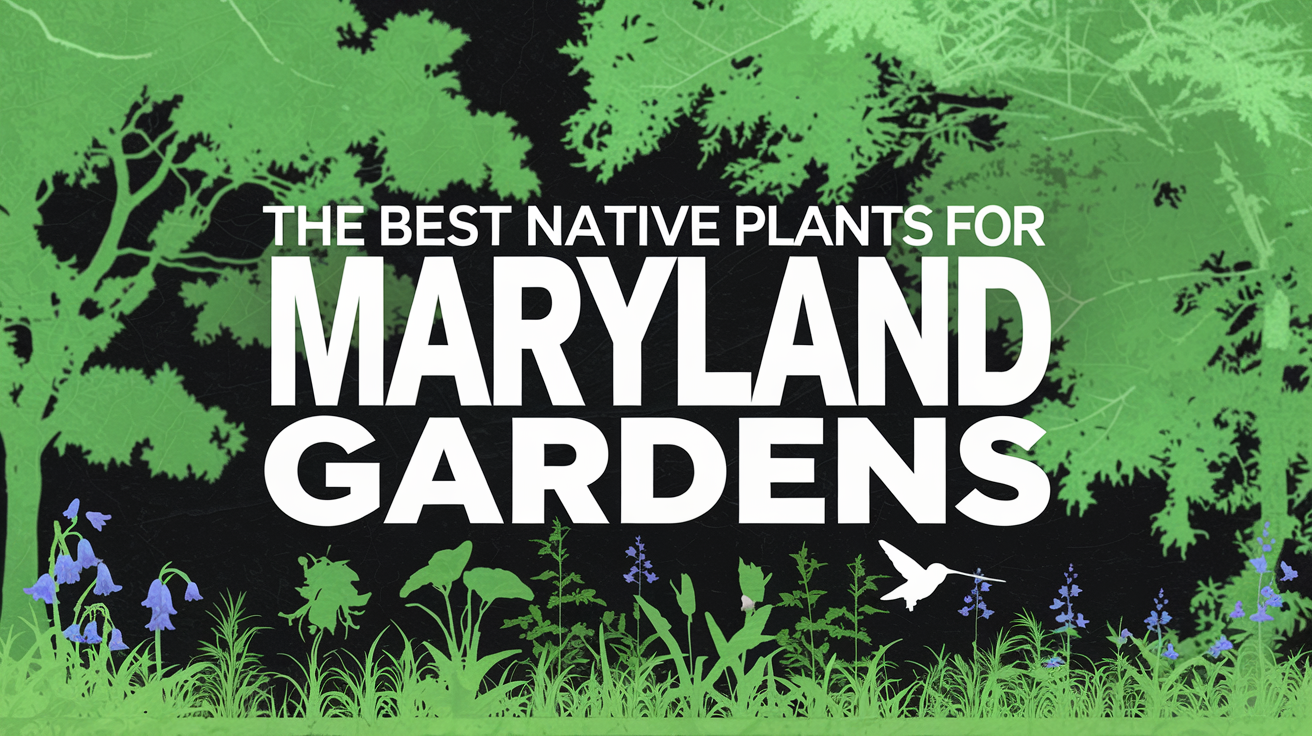Maryland’s diverse landscape offers the perfect canvas for creating stunning gardens with native plants. From the coastal plains to the Piedmont region and the Appalachian Mountains, our state’s varied ecosystems support a rich variety of indigenous flora. At Cox Enterprises, we believe that incorporating native plants into your landscape not only creates a beautiful outdoor space but also supports local wildlife, reduces maintenance needs, and promotes environmental sustainability.

Benefits of Using Native Plants in Your Garden
Native plants have evolved in Maryland’s climate for thousands of years, making them perfectly adapted to our local conditions. This natural adaptation offers numerous advantages for homeowners:
Ecological Benefits
Native plants provide essential habitat and food sources for local wildlife, including pollinators like bees, butterflies, and birds. According to the Maryland Native Plant Society, gardens with native plants support 3-5 times more bird and butterfly species than those dominated by non-native species.
These plants also help maintain biodiversity and strengthen the local ecosystem. As development continues to reduce natural habitats, residential gardens with native plants become increasingly important wildlife corridors and sanctuaries.
Low Maintenance Requirements
Because they’re adapted to local conditions, native plants typically require:
- Less watering once established
- Minimal or no fertilization
- Fewer pesticides and herbicides
- Better resistance to local pests and diseases
This translates to less time and money spent on garden maintenance and a reduced environmental footprint for your property.
Water Conservation
Native plants have root systems adapted to Maryland’s rainfall patterns. Many species develop deep roots that help them survive periods of drought while also preventing soil erosion and improving water quality by filtering runoff.
Top Native Plants for Maryland Gardens
Maryland’s diverse regions support different native plant communities. Here are some outstanding choices for various parts of your landscape:
Trees
Eastern Redbud (Cercis canadensis)
This small, ornamental tree produces stunning pink-purple flowers in early spring before its heart-shaped leaves emerge. Growing to 20-30 feet tall, it’s perfect for smaller yards and provides early-season nectar for pollinators.
American Sweetgum (Liquidambar styraciflua)
With star-shaped leaves that turn brilliant red, orange, and purple in fall, this majestic tree reaches 60-75 feet tall. Its distinctive spiky seed balls provide winter food for birds.
Flowering Dogwood (Cornus florida)
Maryland’s state tree features beautiful white or pink spring flowers, red berries that attract birds, and spectacular red-purple fall foliage. It grows 15-30 feet tall and prefers partial shade.
American Sycamore (Platanus occidentalis)
This fast-growing shade tree features distinctive mottled bark and can reach heights of 75-100 feet. It’s particularly well-suited to wet areas and streambanks.
Shrubs
Virginia Sweetspire (Itea virginica)
This adaptable shrub offers fragrant white flower spikes in spring and outstanding red-purple fall color. Growing 3-5 feet tall, it thrives in sun or shade and tolerates wet conditions.
Inkberry Holly (Ilex glabra)
An evergreen shrub reaching 5-8 feet tall, inkberry provides year-round structure and produces black berries that attract birds. It’s deer-resistant and adapts to various soil conditions.
Smooth Hydrangea (Hydrangea arborescens)
This woodland native produces large white flower clusters in summer that persist into fall. Growing 3-5 feet tall, it prefers partial shade and moist soil.
American Beautyberry (Callicarpa americana)
Known for its spectacular clusters of purple berries in fall, this 3-6 foot shrub attracts birds and provides excellent seasonal interest. It prefers partial shade but tolerates full sun with adequate moisture.
Learn more about incorporating these and other native plants into your landscape design by visiting our native plants page.
Perennials and Wildflowers
Black-Eyed Susan (Rudbeckia hirta)
Maryland’s state flower features bright yellow daisy-like blooms with dark centers from June through September. Growing 2-3 feet tall, it attracts butterflies and provides seeds for birds.
Wild Columbine (Aquilegia canadensis)
This spring-blooming perennial produces distinctive red and yellow nodding flowers that attract hummingbirds. Growing 1-2 feet tall, it prefers partial shade and well-drained soil.
Joe-Pye Weed (Eutrochium purpureum)
Reaching 4-7 feet tall, this impressive perennial produces large clusters of mauve flowers in late summer that are butterfly magnets. It prefers moist soil and partial sun.
Butterfly Weed (Asclepias tuberosa)
This drought-tolerant perennial produces vibrant orange flowers in summer that attract butterflies, particularly monarchs. Growing 1-3 feet tall, it thrives in full sun and well-drained soil.
New England Aster (Symphyotrichum novae-angliae)
This late-blooming perennial provides critical fall nectar for butterflies and bees. Its purple daisy-like flowers appear from August through October on plants reaching 3-6 feet tall.
Grasses and Groundcovers
Switchgrass (Panicum virgatum)
This versatile grass forms upright clumps 3-6 feet tall with airy seed heads that provide winter interest and bird food. It adapts to various conditions and offers excellent erosion control.
Pennsylvania Sedge (Carex pensylvanica)
This low-growing sedge forms a lush carpet of fine-textured foliage 6-12 inches tall. It’s an excellent lawn alternative for shady areas and provides habitat for beneficial insects.
Wild Ginger (Asarum canadense)
This woodland groundcover features heart-shaped leaves and unusual maroon flowers at ground level. Growing 4-8 inches tall, it spreads slowly to form attractive colonies in shady areas.
Designing a Native Plant Landscape
Creating an attractive landscape with native plants requires thoughtful planning and design. Here are key considerations:
Combining Aesthetics with Sustainability
Native plants can be incorporated into various landscape styles, from formal gardens to naturalistic meadows. Consider these design principles:
- Group plants with similar water and light requirements together
- Create layers with trees, shrubs, and groundcovers to mimic natural plant communities
- Include plants with different blooming periods for year-round interest
- Consider plant textures, forms, and colors for visual appeal
- Incorporate hardscape elements like stone walls or paths to add structure
For inspiration and ideas on creating low-maintenance landscapes that look beautiful year-round, visit our low maintenance landscaping page.
Planning for Wildlife
To maximize the ecological benefits of your native plant garden:
- Include at least three species that bloom in each season (spring, summer, and fall)
- Provide a diversity of plant types and structures
- Include host plants for butterfly caterpillars (like milkweed for monarchs)
- Leave some areas unmulched with bare soil for ground-nesting bees
- Avoid using pesticides that harm beneficial insects
- Consider adding water features for additional wildlife habitat
Regional Considerations
Maryland’s diverse regions have different growing conditions. Consider these regional adaptations:
Coastal Plain (Eastern Shore and Southern Maryland)
- Sandy, well-drained soils
- Salt tolerance may be needed near the Chesapeake Bay
- Consider moisture-loving plants in low-lying areas
Piedmont (Central Maryland)
- Clay soils with variable drainage
- More temperature extremes than coastal areas
- Wide variety of native plant options
Appalachian Region (Western Maryland)
- Rocky, sometimes acidic soils
- Colder winters and cooler summers
- Consider woodland natives adapted to mountain conditions
Caring for Native Plants
While native plants generally require less maintenance than exotic species, they still need some care, especially when first established.
Establishment Period
During the first year after planting:
- Water regularly until plants develop deep root systems
- Apply organic mulch to conserve moisture and suppress weeds
- Remove competing weeds that may outgrow young native plants
- Protect new plantings from deer and other wildlife if necessary
Ongoing Maintenance
Once established, native plant gardens require minimal care:
- Water only during extended drought periods
- Avoid over-fertilizing, which can promote excessive growth
- Leave seed heads and dead foliage standing through winter for wildlife
- Cut back perennials in early spring before new growth emerges
- Divide crowded perennials every few years as needed
Seasonal Considerations
Spring
- Remove winter debris and cut back dead perennial foliage
- Apply a thin layer of compost if needed
- Plant new natives early to allow establishment before summer heat
Summer
- Water deeply during drought periods, especially for new plantings
- Remove invasive species that may compete with natives
- Deadhead spent flowers if desired to promote reblooming
Fall
- Plant trees and shrubs to allow root establishment before winter
- Leave seed heads for winter wildlife food
- Apply mulch to new plantings for winter protection
Winter
- Enjoy the structural interest of native grasses and seed heads
- Plan next year’s additions to your native garden
- Order seeds and plants from reputable native plant nurseries
For more information on current landscaping trends and how to incorporate native plants into your design, visit our landscaping trends page.
Conclusion
Creating a garden with Maryland native plants offers multiple benefits – from reduced maintenance and water conservation to supporting local wildlife and enhancing your property’s beauty. At Cox Enterprises, we specialize in designing and installing native plant landscapes that balance ecological function with aesthetic appeal.
Our team of experienced landscapers can help you select the right native plants for your specific site conditions and design preferences. We provide comprehensive services from initial consultation and design to installation and maintenance.
Contact Cox Enterprises today to schedule a consultation and discover how native plants can transform your Maryland garden into a beautiful, sustainable landscape that connects you with our state’s natural heritage.

